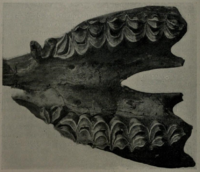Hemiauchenia
| Hemiauchenia | |
|---|---|

| |
| Fossil maxilla of Hemiauchenia cf. paradoxa | |
| Scientific classification | |
| Kingdom: | Animalia |
| Phylum: | Chordata |
| Class: | Mammalia |
| Order: | Artiodactyla |
| Family: | Camelidae |
| Tribe: | Lamini |
| Genus: | †Hemiauchenia Gervais & Ameghino, 1880 |
| Species | |
|
H. macrocephala (Cope, 1893) | |
| Synonyms | |
|
Tanupolama Stock 1928 Holomeniscus Cope 1884 | |
Hemiauchenia,[1] is a genus of lamine camelids that evolved in North America in the Miocene period about 10 million years ago. This genus diversified and moved to South America in the Early Pleistocene, as part of the Great American Biotic Interchange, giving rise to modern lamines. The genus became extinct at the end of the Pleistocene.
Broad features of genus Hemiauchenia[]
The genus name is derived from the Ancient Greek: ἡμι- (hēmi-, "half"-)[2] and αὐχήν (auchēn, "neck").[3][nb 1] Species are specified using Latin adjectives or Latinised names from other languages.
North American fossils[]
Remains of these species have been found in assorted locations around North America, including Florida, Texas, Kansas, Nebraska, Arizona, Mexico, California, Oklahoma, New Mexico, Oregon, Colorado, and Washington.[5] The "large-headed llama", H. macrocephala, was widely distributed in North and Central America, with H. vera being known from the western United States and northern Mexico. H. minima has been found in Florida, and H. guanajuatensis in Mexico.[6]
South American fossils[]
Fossils of Hemiauchenia in South America are restricted to the Pleistocene and have been found in the and of Buenos Aires Province and Córdoba Province, Argentina, the of Bolivia, Pilauco of Osorno, Los Lagos, Chile and Paraíba, Ceará, and the of Rio Grande do Sul, Brazil.[7]
Distinguishing characteristics of members of Hemiauchenia[]
H. vera ( "true hemiauchenia")[]
- Relatively low-crowned teeth (part of visible teeth ends close to gums)
- Large caniniform (canine-like) upper first premolar
- Retention of lower third premolar
H. blancoensis ("Blancan hemiauchenia")[]
- Named for Blancan Age stratum where typically found
- Shorter mandibular diastema (teeth-spacing between incisors and molars) than H. macrocephala and H. vera
- Caniniform upper first premolar
- Absent second premolar
- Upper third premolar present or absent
- Lower crowned molars
H. macrocephala ("great-headed hemiauchenia")[]
- Possesses a larger skull relative to other species
- Long, robust limbs
- Large skeletal size
- Presence of a deciduous upper second premolar
- Fully molariform deciduous second premolar (its infant bicuspids were like molars)
- High-crowned molars
- Thick layer of cementum on the teeth
- Broad mandibular symphysis (line where the bones of the jaw join together) with incisors in a vertical fashion
H. minima ("least hemiauchenia")[]
- Despite being the earliest recognized species, general distinguishing characteristics for H. minima are little known.
Other species[]
Also, a few lesser known species, such as H. paradoxa, H. seymourensis, H. edensis and H. guanajuatensis, have been found. According to which source is consulted, these may or may not be considered legitimate taxa.[citation needed]
Classification history[]
Prior to 1974, fossil specimens now thought to be Hemiauchenia were classified as , Lama, and , until proposed that these North and South American fossil species were part of a single genus.[8] This has been accepted by all subsequent researchers, although in 2013, questioned the inclusion of a certain North American species and suggested that Hemiauchenia is paraphyletic.[citation needed]
Notes[]
References[]
- ^ Paleobiology Database - Hemiauchenia basic info
- ^ ἡμι-. Liddell, Henry George; Scott, Robert; A Greek–English Lexicon at the Perseus Project
- ^ αὐχήν. Liddell, Henry George; Scott, Robert; A Greek–English Lexicon at the Perseus Project
- ^ ὑψηλαυχενία. Liddell, Henry George; Scott, Robert; A Greek–English Lexicon at the Perseus Project
- ^ Hulbert Jr., Richard C.; Valdes, Natali (June 6, 2015). "Hemiauchenia macrocephala". Florida Museum. Florida Museum of Natural History. Retrieved 16 May 2021.
- ^ Ruez, D. R. (2005-09-30). "Earliest Record of Palaeolama (Mammalia, Camelidae) with Comments on "Palaeolama" guanajuatensis". Journal of Vertebrate Paleontology. Society of Vertebrate Paleontology. 25 (3): 741–744. doi:10.1671/0272-4634(2005)025[0741:eropmc]2.0.co;2. JSTOR 4524496.
- ^ Hemiauchenia at Fossilworks.org
- ^ "Hemiauchenia macrocephala". University of Florida, Florida Museum of Natural History. Retrieved 23 May 2016.
Further reading[]
- Honey, J. H., J. A. Harrison, D. R. Prothero, and M. S. Stevens. 1998. Camelidae. pp. 439–462. In: Evolution of Tertiary Mammals of North America, Eds: C. M. Janis, K. M. Scott, and L. L. Jacobs, Cambridge University Press, Cambridge, United Kingdom. 691 pp.
- Hulbert, R. C. 1992. A checklist of the fossil vertebrates of Florida. Papers in Florida Paleontology, no. 6:25-26.
- Kurtén, B. and E. Anderson. 1980. Pleistocene Mammals of North America. Columbia University Press, NY, 442 pp. (camels - 301, 306-307).
- Meachen, Julie A. "A New Species of Hemiauchenia (Camelidae; Lamini)" Diss. University of Florida, 2003. Abstract
- McKenna, M. C. and S. K. Bell. 1997. Classification of Mammals above the Species Level. Columbia University Press, NY, 631 pp. (camels - pp. 413–416).
- Nowak, R. M. 1999. Walker's Book of Mammals, vol. 1. Johns Hopkins University Press, Baltimore, pp. 837 – 1936. (camels - pp. 1072–1081)
- Prehistoric camelids
- Prehistoric even-toed ungulate genera
- Miocene even-toed ungulates
- Pleistocene even-toed ungulates
- Miocene mammals of North America
- Pliocene mammals of North America
- Pleistocene mammals of North America
- Neogene Mexico
- Neogene United States
- Pleistocene El Salvador
- Pleistocene Mexico
- Pleistocene United States
- Fossils of Canada
- Fossils of El Salvador
- Fossils of Mexico
- Fossils of the United States
- Pleistocene mammals of South America
- Lujanian
- Ensenadan
- Uquian
- Pleistocene Argentina
- Fossils of Argentina
- Pleistocene Bolivia
- Fossils of Bolivia
- Pleistocene Brazil
- Fossils of Brazil
- Fossil taxa described in 1880
- Taxa named by Florentino Ameghino
- Ringold Formation Miocene Fauna